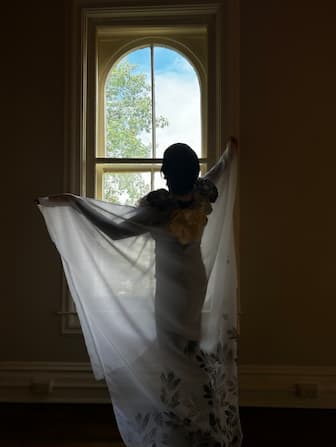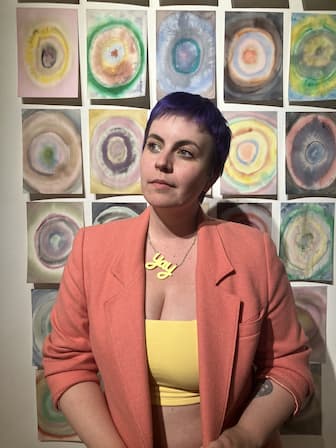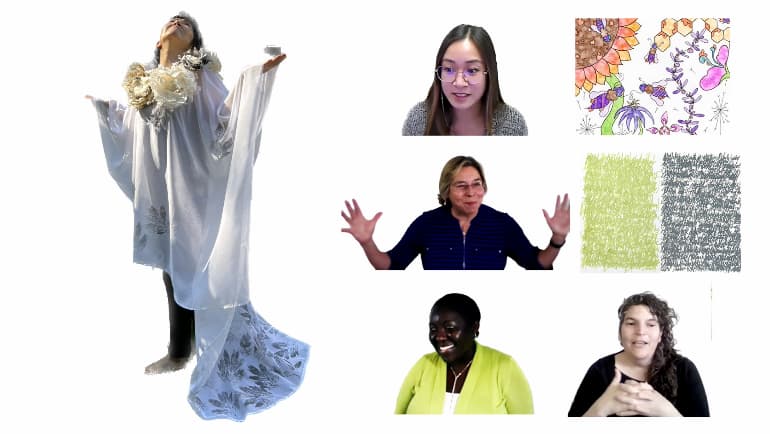IOWA CITY — Satomi Kawai‘s jewelry designs are featured in distinguished permanent collections in Switzerland, Italy and New York. Her work has been displayed on its own or with collections throughout the United States and also in Germany, Spain, South Korea, France and more.
And yet, there’s something very approachable that has impacted Kawai more than anything else: Zumba.
That’s right. The Columbian exercise regimen that you can find in almost any gym or rec center, that’s so popular it’s become a favorite butt of jokes, helped transform Kawai as an artist.
Zumba helped propel Kawai from jewelry, wearable art, and mixed-media, into performance art. And, it connected Kawai with the dozens of women who have helped her create “Women hood: 2nd edition,” which Kawai will release Saturday evening in a reception at the Women’s Resource and Action Center in the Bowman House, 230 N. Clinton St., Iowa City.
The show features “responsive art” created by five artists, after listening to Kawai’s interviews with multi-cultural women. The result is the artists’ takes on the “experience of femininity,” combined with Kawai’s own take, which is informed her extensive interviews over five years and her upbringing in Japan.
Kawai’s performance art will be a highlight of the reception. So will Vero Rose Smith‘s art created from transcriptions of the interviews, in colors that help communicate the subjects’ input.

Satomi Kawai is an internationally known jewelry designer and wearable art creator who is also delving into performance art.
Japanese culture taught Kawai to be “submissive”
While growing up in a small conservative Japanese village, Kawai says, she was pressured to be quiet. It was an expectation she defied regularly. “People said to me sometimes, when I spoke out very honest opinions about men, they said, ‘you shouldn’t say that. You need to be very quiet and obedient.’ “
When she relocated to Iowa City 24 years ago, Kawai said, she unintentionally adopted the same submissive demeanor she had so regularly defied while living in Japan. “I felt as though I didn’t have any voice,” she remembers. “I couldn’t speak out, because I didn’t know how to do it. I was quiet, and tried to be obedient.”
She credits two things with helping her find her voice again: constant input from her American colleagues and friends to speak up, and Zumba.
At first, Zumba was a healthy practice recommended by her doctor to ease body aches. But it became much more, especially after she became a Zumba instructor eight years ago.
“I (used to be) so intimidated to speak out something I really wanted to say,” she remembers. “But it’s so weird. After Zumba, I really needed to entertain people, enjoy life, and share my energy with other people.”
Many of the women she met in her Zumba classes were, like herself, from other cultures. Kawai decided to expand her exploration into the “feminine experience” to learn about what others experienced. The result was a first showing of womanhood in 2020, virtually. This second edition is the first chance for “Woman: hood” to be presented in person.
Vero Rose Smith, one of the artists to be featured, says she found some common themes after listening to the women Kawai interviewed: “a sense of justice, a sense of care for others, looking for belonging, and a better world for all people.” She said the exhibit communicates “so many things.”

Vero Rose Smith is among the artists who will be featured in Satomi Kawai’s “Woman: hood”
“It gives us an oral history of what it is like to identify as a woman in the state of Iowa, which is an increasingly harried and difficult prospect given legislation that keeps getting put forth in the Statehouse around women’s bodies,” said Smith, referring to Iowa’s newly restrictive abortion laws.
Her own artwork consists of the artistic transcription of phrases from Kawai’s interviews, with numerous layers, in colors Smith chose based on her artistic understanding of color. She describes it as built “around the ideas of listening, and how can we take someone else’s unknowable story into our own consciousness…. How can we create empathy through action and the act of listening?”
Kawai says her grandmother also influenced her art. Once an aspiring jewelry designer herself, Kawai’s grandmother gave up the dream when she contracted tuberculosis. She remembers her grandmother constantly drawing, writing, sewing and more — and encouraging her to join in.
“She lived a long life, and passed away when she was 93,” Kawai says. “But she had to give up her career dream. That’s why (I feel) I should always do whatever I can to follow through on my dream.”
You can learn more about “Woman: Hood” here, and all of the featured artists, here. To explore more of Kawai’s artwork, head to her website, Instagram page or Facebook page.
(cover photo features Satomi Kawai, left, and some subjects and art samples from Woman: hood. courtesy Satomi Kawai)


